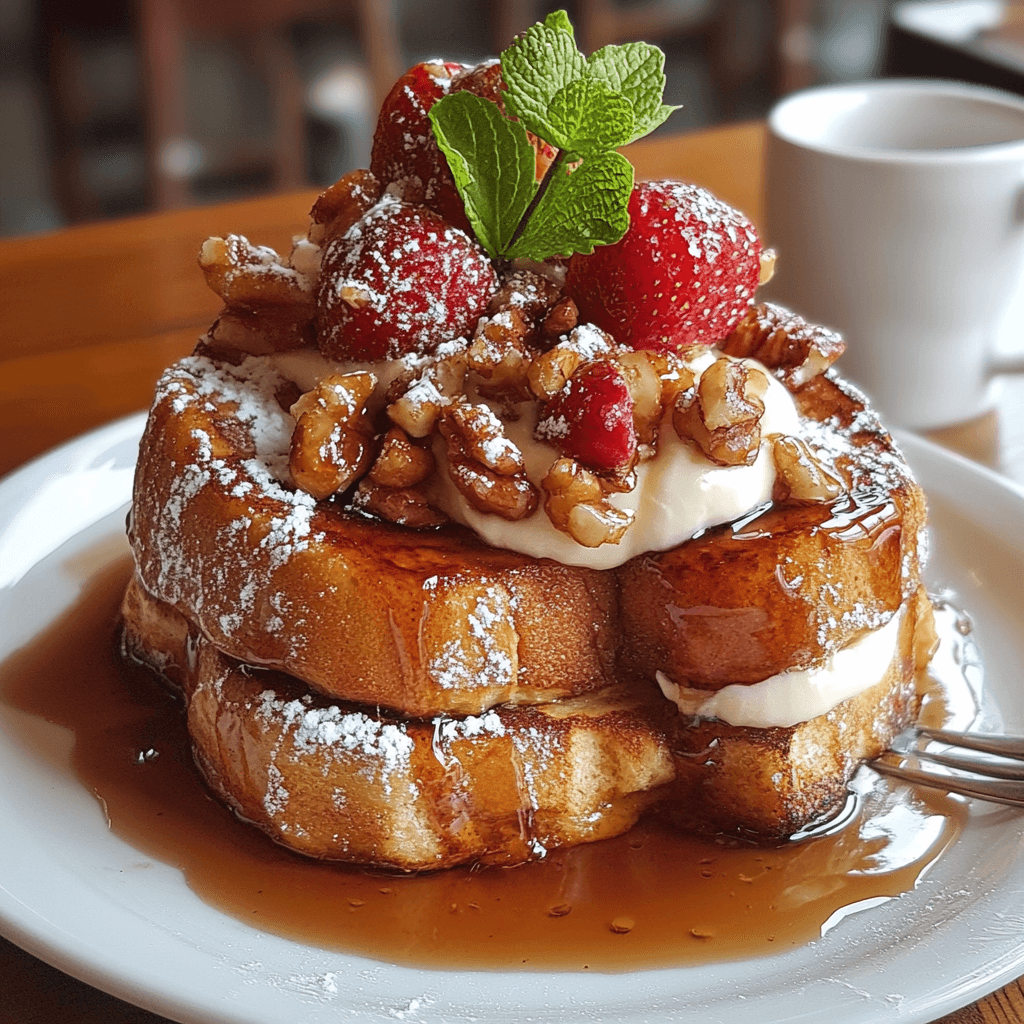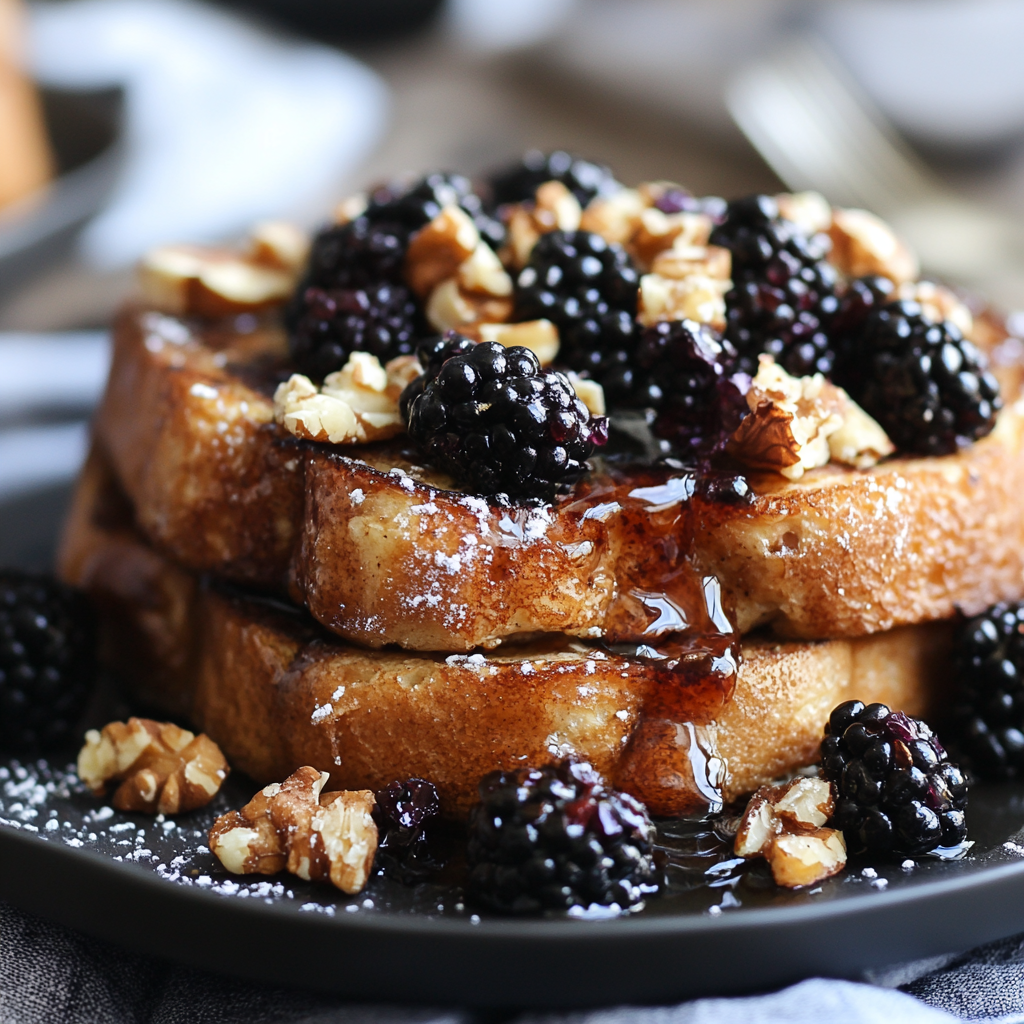Introduction to Brioche French Toast
Why Brioche French Toast is a Breakfast Favorite
Brioche French toast elevates the classic breakfast staple to a luxurious dish. Its rich, buttery texture and slightly sweet flavor make it the perfect bread for absorbing the creamy egg custard mixture. Whether served for a leisurely weekend breakfast or an elegant brunch, Brioche French toast is a crowd-pleaser, offering a soft, custardy interior with a golden, crispy exterior.
What Makes Brioche Bread Special?
Brioche is a French bread enriched with eggs and butter, giving it a tender crumb and rich flavor. Its light, fluffy texture and subtle sweetness make it an ideal base for French toast, as it absorbs the egg mixture without becoming soggy. Brioche stands out from regular bread due to its ability to stay soft and hold its shape even when soaked, ensuring a perfectly decadent bite every time.
Ingredients You Need for Brioche French Toast
Essential Ingredients for a Perfect French Toast
To make the ultimate Brioche French toast, gather these essential ingredients:
- Brioche Bread: Thick slices of slightly stale brioche work best.
- Eggs: The foundation of the custard mixture for structure and richness.
- Milk or Cream: Whole milk or heavy cream adds a velvety texture to the custard.
- Vanilla Extract: Provides a warm, sweet aroma.
- Cinnamon or Nutmeg: Adds depth and warmth to the flavor.
- Sugar: A small amount sweetens the mixture without overpowering the dish.
- Butter: For frying and achieving that golden-brown crust.
Choosing the Best Quality Brioche Bread
- Look for artisanal brioche loaves or bakery-fresh brioche for the best quality.
- Opt for thick-cut slices (around 1 inch) to hold up well when dipped in the custard.
- If fresh brioche is unavailable, allow it to sit out for a day to slightly stale—this helps it absorb the custard without falling apart.
Substitutions for Common Ingredients
If you’re missing some ingredients, here are quick substitutions:
- Bread: Use challah, French bread, or even Texas toast as alternatives.
- Milk/Cream: Substitute with almond milk, oat milk, or coconut milk for a dairy-free option.
- Sugar: Swap white sugar for honey, maple syrup, or a sugar alternative.
- Vanilla Extract: Replace with almond extract or a sprinkle of vanilla bean paste.
Step-by-Step Instructions to Make Brioche French Toast
Preparing the Egg Custard Mixture
- In a shallow dish or bowl, whisk together:
- 2 large eggs
- ½ cup of milk or cream
- 1 tablespoon of sugar
- 1 teaspoon of vanilla extract
- ½ teaspoon of ground cinnamon (optional)
- A pinch of salt to balance the flavors.
- Whisk until smooth and well combined, ensuring there are no lumps of egg.
Dipping the Brioche: Achieving the Perfect Soak
- Slice the Bread: Use thick slices (around 1 inch) of slightly stale brioche bread.
- Dip Quickly: Gently dip each side of the bread slice into the custard mixture, letting it soak for 5–10 seconds per side. Avoid oversoaking, as the bread can become too soft and break apart.
- Let Excess Drip: Allow any excess custard to drip off before transferring the bread to the pan.
Cooking the French Toast to Golden Perfection
- Heat the Pan: Melt 1–2 tablespoons of butter in a non-stick skillet or griddle over medium heat.
- Cook the Brioche: Place the soaked brioche slices into the skillet and cook for 2–3 minutes per side, or until golden brown and crispy on the outside.
- Avoid Overcrowding: Cook in batches if necessary to ensure even cooking.
- Serve Immediately: Transfer to a plate and keep warm if needed. Top with powdered sugar, fresh fruit, or a drizzle of maple syrup for a truly luxurious breakfast.
By following these simple steps, you’ll create perfectly cooked Brioche French toast that’s crispy on the outside, soft and custardy on the inside, and absolutely delicious.
Tips and Tricks for Perfect Brioche French Toast
Preventing Soggy French Toast
To avoid soggy French toast, follow these tips:
- Use slightly stale brioche as it absorbs the custard without falling apart. Fresh bread can become too mushy.
- Dip the brioche slices briefly—5–10 seconds per side is enough to coat without oversaturating.
- Cook the toast over medium heat so the inside cooks fully while the outside develops a golden crust.
The Ideal Thickness for Brioche Slices
For the perfect texture, slice your brioche bread to a thickness of 1 to 1.5 inches. Thick slices hold their shape, soak up the custard evenly, and create a soft yet firm center. Avoid thin slices, as they may tear or become too soggy.
Controlling the Skillet Temperature
Temperature control is key to golden, evenly cooked French toast:
- Heat your skillet over medium heat to ensure the toast cooks through without burning.
- Add a bit of butter to the pan for flavor, but watch that it doesn’t burn—adjust the heat if needed.
- If cooking multiple slices, wipe the skillet between batches to prevent burnt butter or custard residue.
Sweet Variations of Brioche French Toast
Classic Cinnamon and Vanilla Flavor
For a timeless favorite:
- Add an extra teaspoon of cinnamon and ½ teaspoon of nutmeg to the custard mixture.
- Serve with a dusting of powdered sugar and a generous drizzle of maple syrup for a comforting, familiar flavor.
Caramelized Banana and Nutella French Toast
For a decadent treat:
- Spread Nutella on one slice of brioche before dipping in the custard.
- Top with caramelized bananas: Cook sliced bananas with butter, brown sugar, and a pinch of cinnamon until golden and syrupy.
- Garnish with chopped hazelnuts for extra crunch.
Brioche French Toast with Berries and Whipped Cream
For a fresh and fruity variation:
- Top your cooked French toast with a mix of fresh strawberries, blueberries, and raspberries.
- Add a dollop of lightly sweetened whipped cream and a drizzle of honey or maple syrup.
- Sprinkle with a pinch of powdered sugar for an elegant finish.
Savory Variations of Brioche French Toast
Cheesy Brioche French Toast with Ham
For a savory and filling option:
- Add shredded cheddar or gruyere cheese to the custard mixture.
- Once cooked, layer the toast with slices of ham and additional cheese.
- Serve warm, optionally topped with a fried egg for extra protein.
Brioche French Toast with Smoked Salmon and Cream Cheese
For an elegant brunch twist:
- Spread softened cream cheese on cooked French toast slices.
- Top with smoked salmon, fresh dill, and a squeeze of lemon juice.
- Garnish with thinly sliced red onions and capers for a sophisticated, savory finish.
Herb-Infused Savory Custard French Toast
For a flavor-packed variation:
- Add finely chopped fresh herbs like parsley, thyme, and chives to the custard mixture.
- Include a pinch of garlic powder and black pepper for extra depth.
- Serve with sautéed mushrooms, cherry tomatoes, or a sprinkle of Parmesan cheese.
With these sweet and savory variations, you can tailor your Brioche French toast to suit any taste or occasion. Whether you’re craving something indulgent and sweet or sophisticated and savory, these recipes ensure a delicious and versatile breakfast experience every time.
Topping Ideas to Elevate Brioche French Toast
Traditional Toppings: Maple Syrup and Powdered Sugar
Sometimes, the classics are unbeatable. Elevate your Brioche French toast with these timeless toppings:
- Maple Syrup: A warm drizzle of pure maple syrup complements the buttery richness of the brioche.
- Powdered Sugar: A light dusting of powdered sugar adds a touch of sweetness and a beautiful, elegant finish.
- Butter: Top with a pat of butter that melts into the toast, adding extra creaminess and flavor.
Creative Toppings: Fresh Fruits, Nuts, and Honey Drizzle
For a fresh and vibrant twist, try these creative topping ideas:
- Fresh Fruits: Top with slices of strawberries, bananas, or a handful of blueberries and raspberries for a refreshing burst of flavor.
- Nuts: Add a satisfying crunch with toasted almonds, walnuts, or pecans.
- Honey Drizzle: Replace maple syrup with a light drizzle of golden honey for natural sweetness and a hint of floral notes.
Unique Additions: Whipped Cream, Chocolate Sauce, or Caramel
Take your Brioche French toast to the next level with indulgent toppings:
- Whipped Cream: A generous dollop of whipped cream creates a light, airy texture that pairs perfectly with sweet variations.
- Chocolate Sauce: Drizzle melted dark, milk, or white chocolate over the toast for a rich and decadent treat.
- Caramel Sauce: Add a drizzle of warm caramel for a buttery, sweet topping that complements both plain and fruit-filled French toast.
- Nut Butters: Spread almond butter, peanut butter, or hazelnut spread for a protein-packed and creamy addition.

Pairing Suggestions for Brioche French Toast
Best Beverages to Serve with French Toast
Complement the rich, buttery flavors of Brioche French toast with the perfect beverage:
- Coffee: Pair with a freshly brewed cup of coffee, a cappuccino, or a latte for a balanced breakfast.
- Tea: Light teas such as Earl Grey or chai provide a warming contrast to the richness of the dish.
- Fresh Juices: Serve with freshly squeezed orange juice, apple juice, or a fruity smoothie for a refreshing pairing.
- Hot Chocolate: For a special treat, pair sweet variations of French toast with a creamy, warm cup of hot chocolate.
Sides That Complement Brioche French Toast
Enhance your Brioche French toast experience with these complementary sides:
- Bacon or Sausage: The salty, savory flavor of crispy bacon or sausage balances the sweetness of the French toast.
- Fresh Fruit Salad: A light and colorful fruit salad made with berries, melon, and citrus adds a refreshing contrast.
- Scrambled Eggs: Serve soft, fluffy scrambled eggs on the side for a protein-packed addition that completes the meal.
- Greek Yogurt: A bowl of plain or honey-sweetened Greek yogurt pairs beautifully with fresh fruit and adds a creamy, tangy element.
- Roasted Potatoes: For a hearty brunch, pair French toast with crispy, golden roasted potatoes seasoned with herbs.
By pairing Brioche French toast with the right toppings, beverages, and sides, you can create a balanced, indulgent meal perfect for any breakfast or brunch occasion. Whether you lean toward classic simplicity or gourmet creativity, these suggestions ensure a delightful experience.
Nutritional Information for Brioche French Toast
Macronutrients Breakdown (Calories, Fat, Protein, Carbs)
The nutritional content of Brioche French toast depends on ingredients and portion sizes. Here is an approximate breakdown per serving (1 slice of brioche with custard):
- Calories: 300–350 kcal (depending on toppings and cooking fat).
- Carbohydrates: 35–40g (from bread and added sugar).
- Protein: 8–10g (from eggs and milk).
- Fat: 12–18g (from eggs, milk, and butter).
Adding toppings like whipped cream, syrup, or chocolate sauce will increase the calorie and sugar content, while healthier toppings like fresh fruit and nuts provide fiber and nutrients.
Adjustments for Healthier Options
To make Brioche French toast lighter and more nutritious:
- Use Whole-Grain Bread: Replace brioche with whole-grain or sprouted bread for added fiber and nutrients.
- Lighten the Custard: Use egg whites or a mix of one whole egg and one egg white. Swap whole milk for almond milk, oat milk, or skim milk.
- Reduce Sugar: Omit added sugar in the custard and rely on natural sweetness from toppings like fruit or a light drizzle of honey.
- Cooking Fat: Use a non-stick skillet with a light spray of oil or coconut oil instead of butter.
- Toppings: Opt for fresh berries, nuts, or Greek yogurt instead of high-calorie syrups and whipped cream.
These simple adjustments allow you to enjoy a healthier version of Brioche French toast without compromising flavor.
Make-Ahead and Storage Tips
How to Prepare Brioche French Toast Ahead of Time
Brioche French toast can be prepped in advance, making it perfect for busy mornings or brunch gatherings:
- Prepare the Custard: Whisk the egg custard mixture the night before and store it in an airtight container in the refrigerator.
- Pre-Soak the Bread: Dip the brioche slices in the custard, place them on a baking sheet lined with parchment paper, and refrigerate overnight. This allows the bread to fully absorb the mixture.
- Cook When Ready: In the morning, cook the pre-soaked slices directly in a skillet or on a griddle until golden brown.
Alternatively, you can fully cook the French toast, store it, and reheat it when ready to serve.
Reheating and Freezing Leftover French Toast
Reheating:
- Skillet: Reheat on a non-stick skillet over medium heat for 2–3 minutes per side to restore its crisp texture.
- Oven: Preheat the oven to 350°F (175°C). Place slices on a baking sheet and warm for 8–10 minutes.
- Toaster: For quick reheating, pop slices in a toaster or toaster oven on a medium setting.
- Microwave: Use short bursts (20–30 seconds) to avoid soggy results.
Freezing Leftovers:
- Allow cooked French toast slices to cool completely.
- Place slices in a single layer on a baking sheet and freeze for 1–2 hours.
- Transfer frozen slices to a freezer-safe bag or airtight container, separating layers with parchment paper.
- Freeze for up to 2 months.
Reheat from Frozen: Place slices in a preheated oven at 350°F (175°C) for 10–12 minutes or heat them in a toaster oven until warmed through and crispy.
With these tips, you can prepare Brioche French toast ahead of time, store leftovers efficiently, and enjoy this luxurious breakfast any day of the week!
Common Mistakes to Avoid When Making Brioche French Toast
Oversoaking the Bread
One of the most common mistakes is oversoaking the bread in the custard mixture. While brioche is sturdy and absorbent, soaking it too long can cause it to become mushy and fall apart during cooking. To avoid this:
- Dip each side of the bread in the custard for 5–10 seconds—just enough to coat without saturating.
- Allow any excess custard to drip off before placing the bread in the skillet.
Cooking on the Wrong Heat
Cooking Brioche French toast at the wrong temperature can ruin the texture.
- High Heat: Cooking on high heat causes the outside to burn while leaving the inside raw and custardy.
- Low Heat: Cooking on low heat results in a pale, soggy toast without the golden-brown crispiness.
- Solution: Use medium heat for an even, golden-brown crust while ensuring the inside is perfectly cooked. Always preheat the skillet and melt the butter until it sizzles gently.
Skipping the Right Toppings
Brioche French toast is rich and flavorful on its own, but skipping toppings can make it feel incomplete. The right toppings enhance both the flavor and presentation of the dish.
- For a sweet version, add maple syrup, powdered sugar, fresh fruit, or whipped cream to elevate the dish.
- For a savory variation, consider toppings like smoked salmon, herbs, or a poached egg with hollandaise sauce.
- Balance is key—avoid overloading the toast so its buttery brioche flavor still shines through.
By avoiding these common mistakes, you’ll ensure your Brioche French toast turns out perfectly golden, flavorful, and indulgent every single time!
Frequently Asked Questions About Brioche French Toast Recipe
What is the Best Bread for French Toast?
The best bread for French toast is brioche, thanks to its rich, buttery flavor and soft, fluffy texture. Other excellent options include challah and French bread. These breads are sturdy enough to soak up the custard without falling apart and deliver a perfect golden crust when cooked.
Can I Make Brioche French Toast Without Eggs?
Yes, you can make egg-free Brioche French toast by substituting eggs with alternatives like:
- Flaxseed Mixture: Combine 1 tablespoon of ground flaxseed with 3 tablespoons of water to create a “flax egg.”
- Cornstarch Slurry: Use 1 tablespoon of cornstarch mixed with 3 tablespoons of milk for binding.
- Banana or Applesauce: Use mashed banana or applesauce for a vegan and slightly sweet custard alternative.
How Do I Prevent Soggy French Toast?
To avoid soggy French toast:
- Use slightly stale bread as it absorbs the custard without becoming mushy.
- Dip the bread quickly—5–10 seconds per side—to avoid oversaturation.
- Cook over medium heat to allow the toast to cook through evenly while achieving a golden-brown exterior.
Can I Use Dairy-Free Milk in the Recipe?
Absolutely! Replace regular milk or cream with dairy-free alternatives like:
- Almond milk
- Oat milk
- Coconut milk (full-fat for a creamy texture)
- Soy milk
These options work well and still create a delicious, custardy French toast.
How Long Should I Cook Brioche French Toast?
Cook each slice of Brioche French toast for about 2–3 minutes per side over medium heat. The goal is a crispy, golden-brown crust with a soft, custardy interior. Avoid high heat, as it can burn the outside before the inside is fully cooked.
Is It Possible to Make a Vegan Version of Brioche French Toast?
Yes, you can make a vegan version of Brioche French toast by:
- Using vegan brioche (available at specialty stores or bakeries).
- Replacing eggs with a flax egg or cornstarch slurry.
- Substituting regular milk with plant-based alternatives like almond, soy, or oat milk.
- Cooking with vegan butter or coconut oil for frying.
Should You Dry Out Brioche Before Making French Toast?
Yes, drying out brioche slightly makes it perfect for French toast. Stale or slightly dry bread absorbs the custard without becoming too mushy. If your brioche is fresh, lightly toast it in the oven at 300°F (150°C) for about 5–7 minutes to dry it out.
How to Make Brioche French Toast Not Soggy?
To prevent sogginess:
- Use thick slices of slightly stale brioche.
- Dip the bread briefly in the custard mixture—just enough to coat.
- Cook over medium heat and avoid overcrowding the pan to ensure even cooking.
What is the Most Common Mistake in Making French Toast?
The most common mistake is oversoaking the bread, which makes the toast soggy and unappetizing. Always dip the bread for 5–10 seconds per side and let any excess custard drip off before cooking.
What is the Trick to Good French Toast?
The key to perfect French toast lies in:
- Using high-quality bread like brioche or challah.
- Maintaining the right egg-to-milk ratio for a creamy custard.
- Cooking over medium heat with butter for a golden, crispy exterior and soft center.
- Adding flavorings like vanilla, cinnamon, and a pinch of salt to elevate the taste.
By following these tips and addressing common questions, you can master the art of making Brioche French toast for a luxurious and foolproof breakfast experience!
To provide additional value in your “Brioche French Toast Recipe” article, consider linking to other related recipes that inspire delicious breakfast ideas. For readers interested in unique variations of French toast, suggest The Ultimate Stuffed French Toast Recipe, which takes breakfast to another level with rich, customizable fillings. If they prefer single-serving options, direct them to The Ultimate French Toast Recipe for 1, perfect for quick, individual meals. For pancake lovers looking for alternatives, encourage them to explore The Ultimate Guide to the Perfect German Pancake Recipe for a light and fluffy breakfast option.
These internal links not only enhance the user experience but also encourage readers to explore more of your content while staying engaged with your site.
What’s the best way to store leftovers?
Keep leftovers in an airtight container in the fridge for up to 4 days. Reheat in the microwave or oven until hot and bubbly. For food safety tips, refer to USDA guidelines on leftovers .
Conclusion
Final Thoughts on Crafting the Perfect Brioche French Toast
Brioche French toast is the ultimate way to elevate a classic breakfast into a luxurious and unforgettable experience. With its buttery, tender texture and ability to soak up the rich custard mixture perfectly, brioche bread transforms a simple dish into a gourmet treat. By mastering the right techniques—such as avoiding oversoaking, cooking at the correct temperature, and experimenting with creative toppings and variations—you can achieve a perfect balance of golden crispness and soft, custardy richness every time.
Whether you’re making it for a relaxing weekend brunch, a special occasion, or a quick indulgence, Brioche French toast offers endless possibilities for sweet and savory twists. Pair it with your favorite beverages, fresh fruits, or complementary sides to complete the meal. With attention to detail and quality ingredients, you’ll craft a French toast recipe that’s as beautiful as it is delicious, leaving everyone asking for seconds!






3 thoughts on “The Best Brioche French Toast Recipe for a Luxurious Breakfast”
Comments are closed.